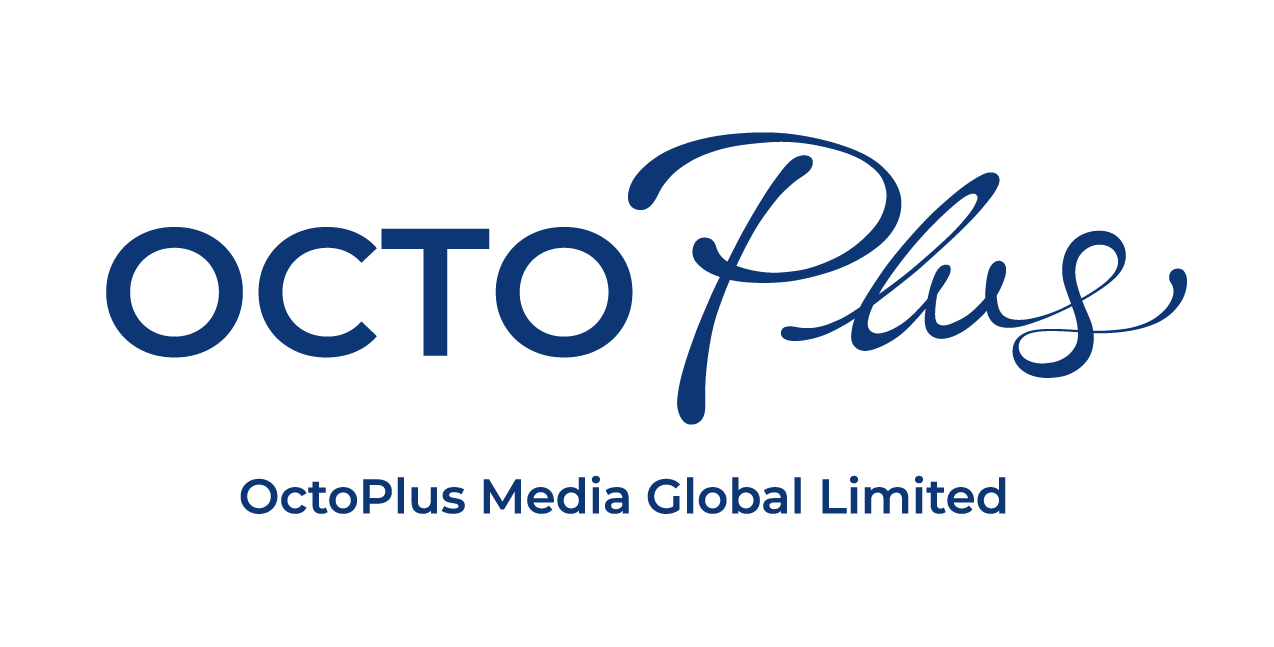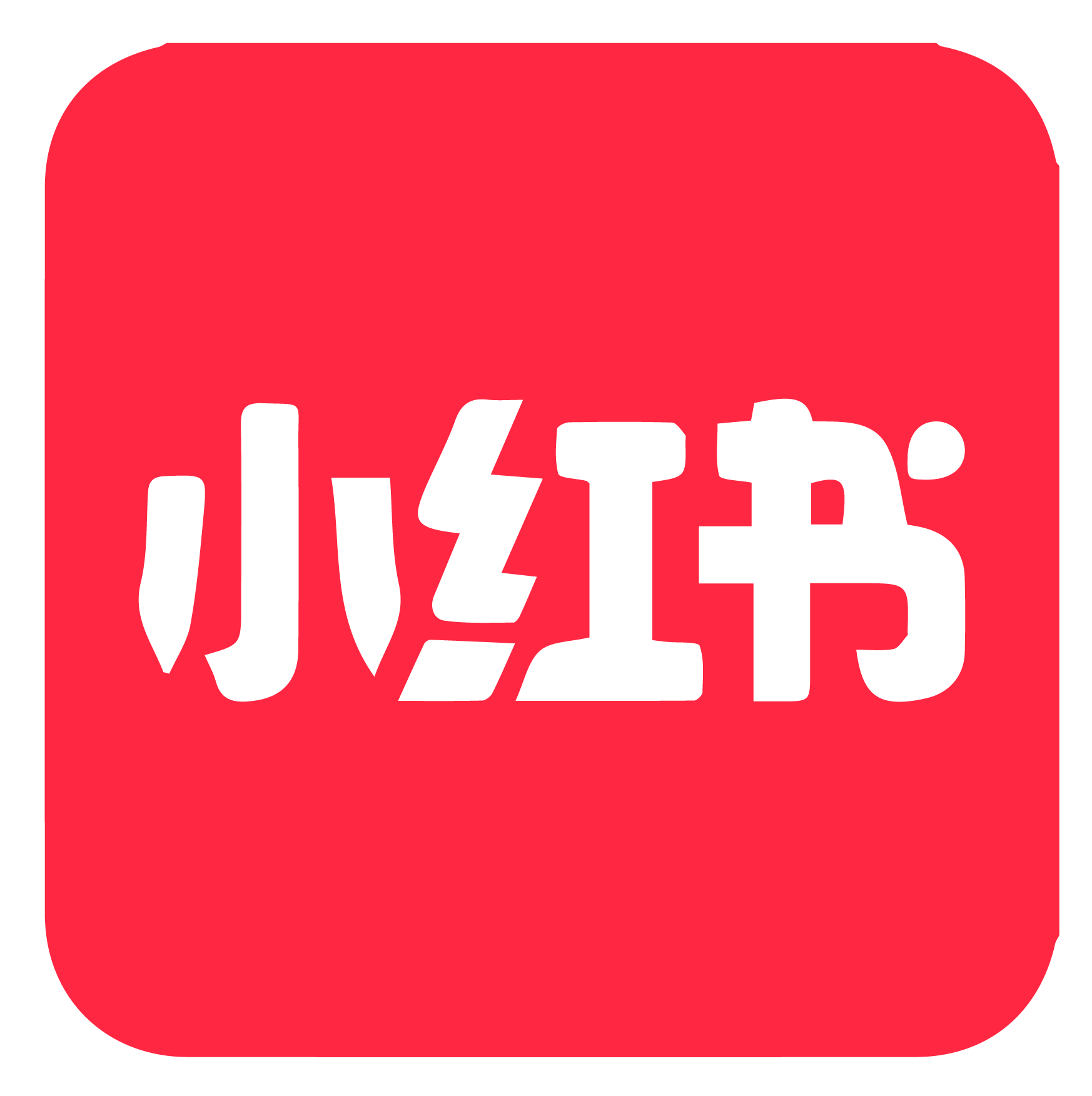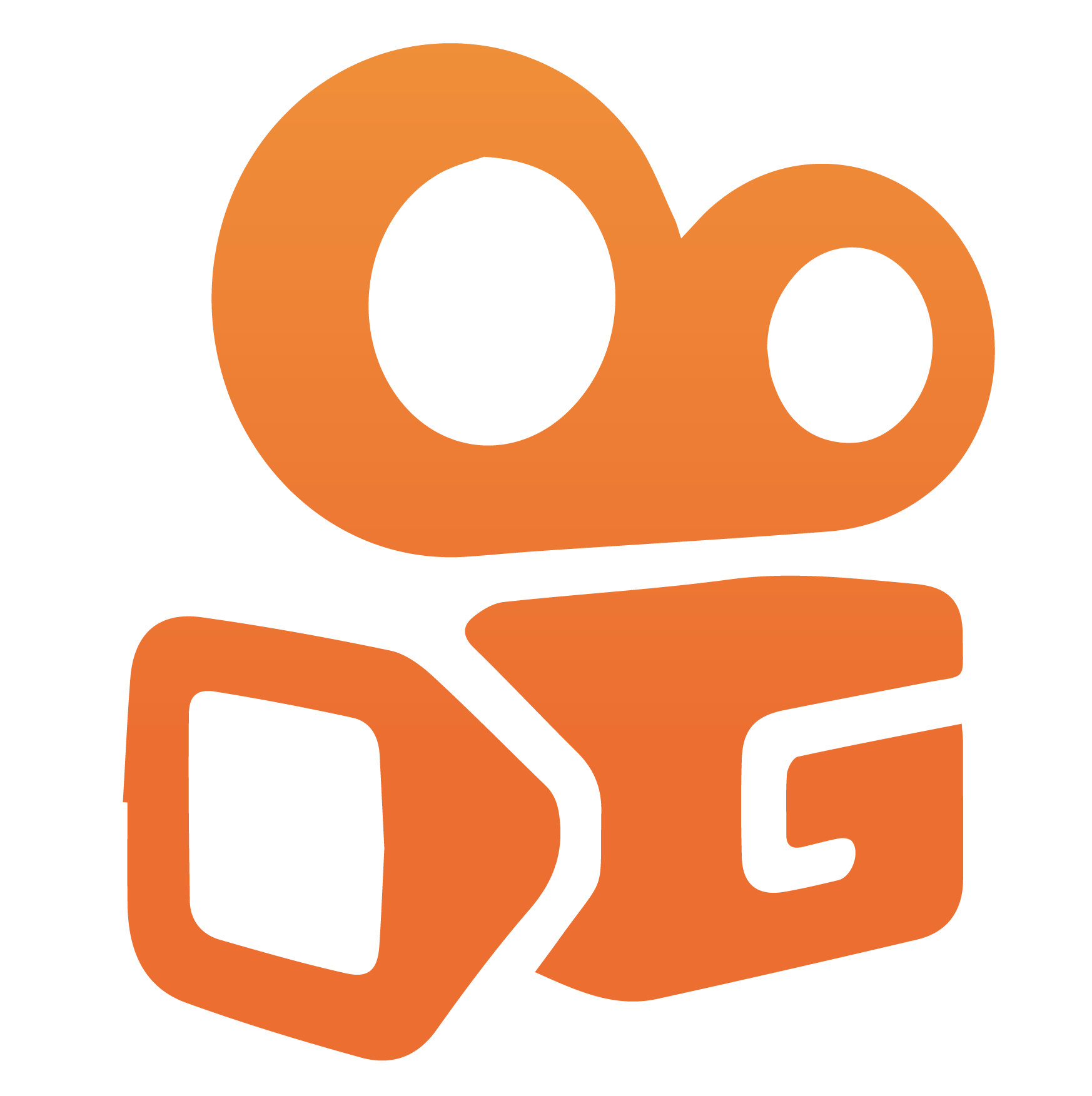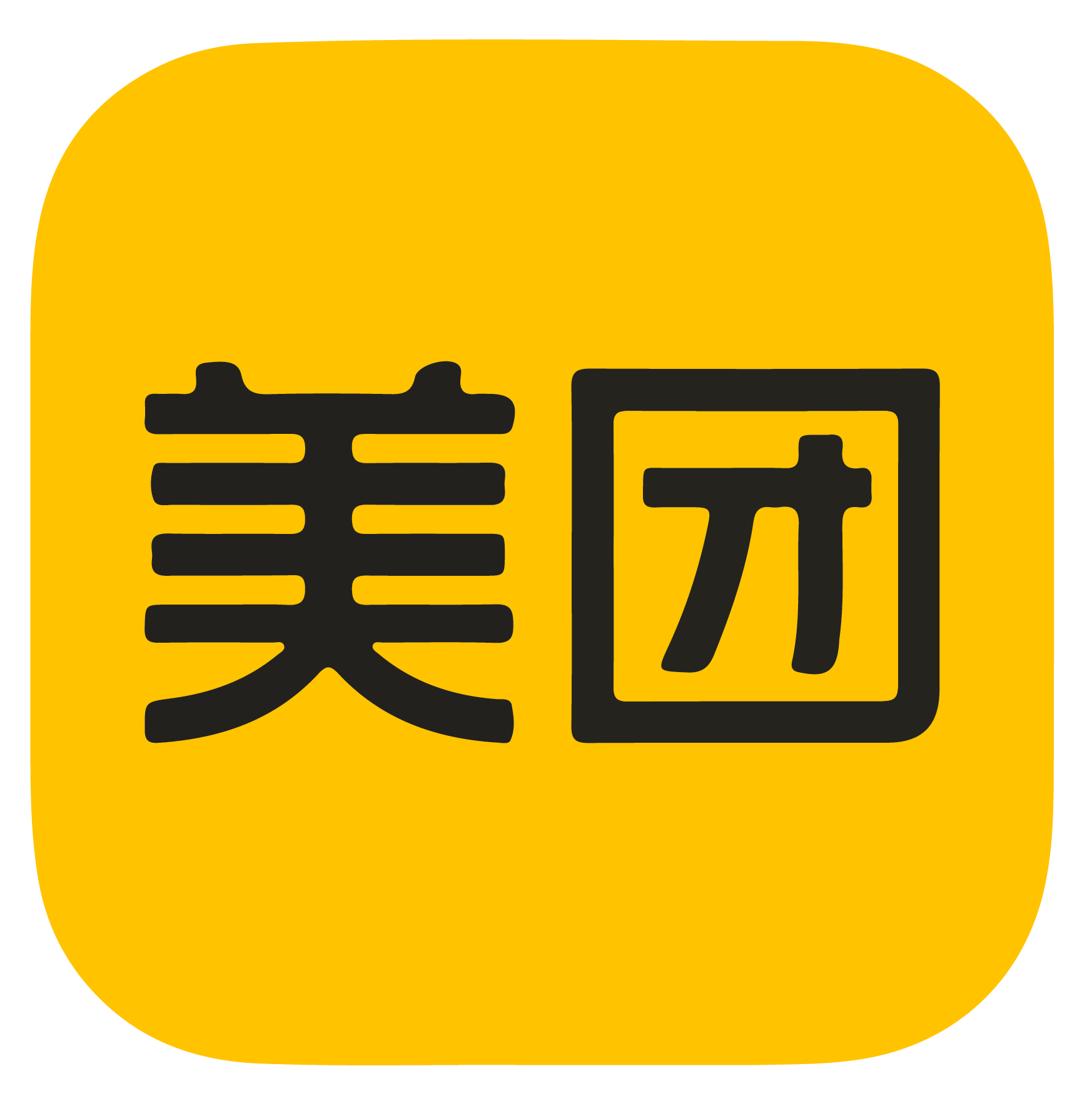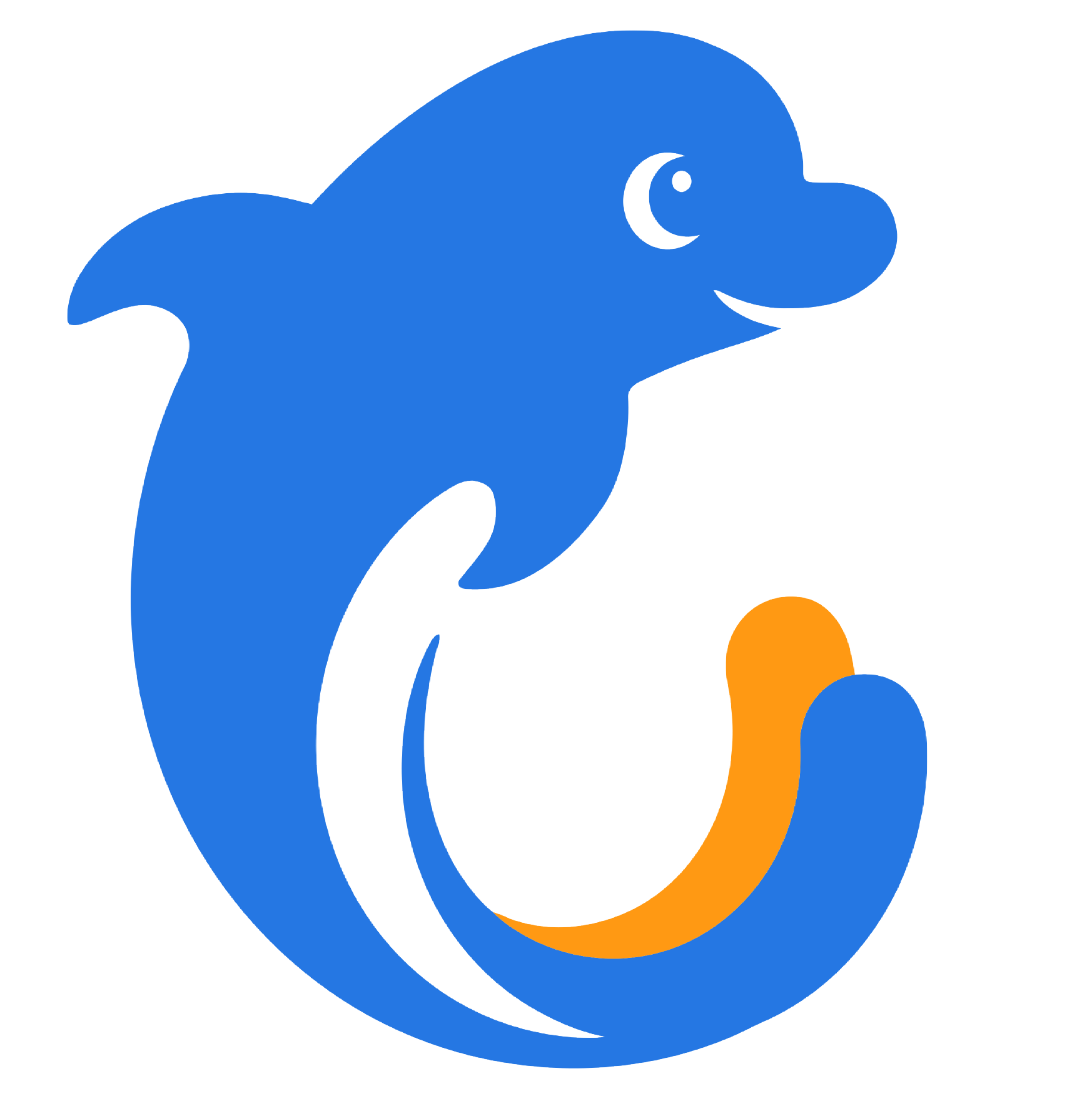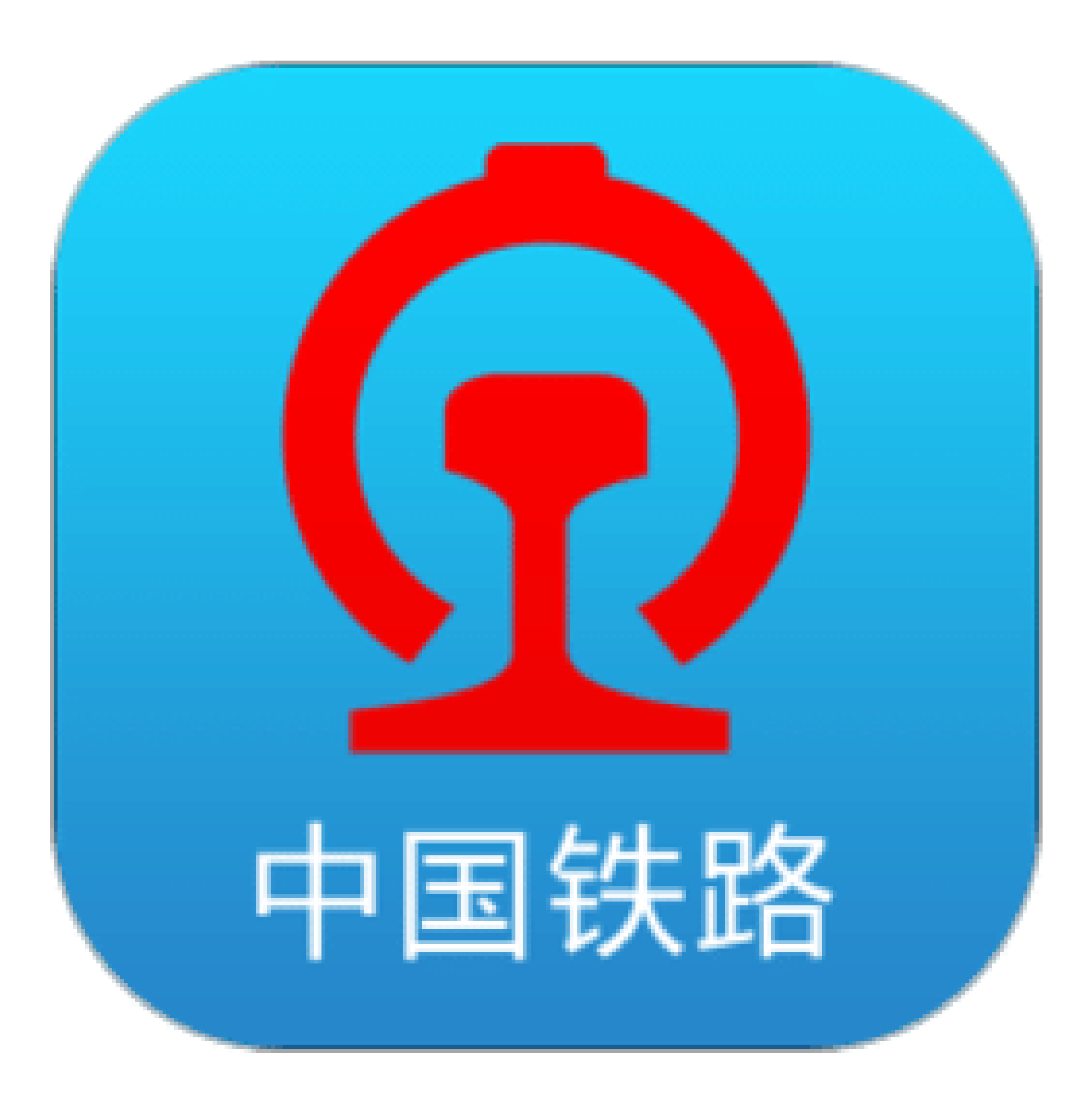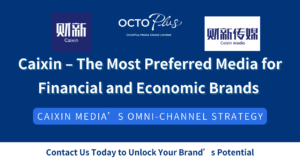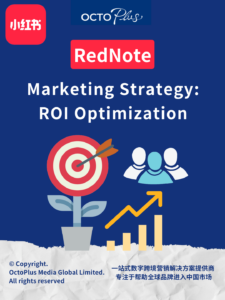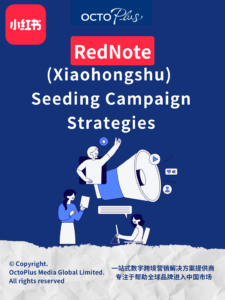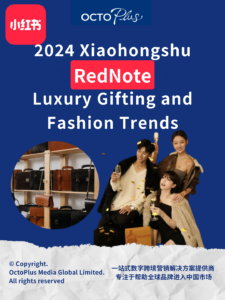China Marketing Insights Monthly Newsletter [December 2021]



Welcome to our December Newsletter.
We start our newsletter with monthly update on tech crackdown, hopefully, as the year comes to a close and we move into 2022 there is more normalization in the crackdown and more certainty for everyone involved.
In this issue, we look at insight report about Chinese travelers sentiment in 2022. We look at insights from Tencent & Kantar about GenZ consumption and 11.11 report from RED. Finally, we have OTT commercialization & media value report from our partner Miaozhen.
We wrap up this newsletter with App of the month – AutoNavi (Gaode Map in China) – China’s largest map application.
From all of us here at OctoPlus Media, wishing you all a Very Merry Christmas & a Happy New Year! May 2022 bring a lot of joy & prosperity and not be a 2020-too!
Sincerely,
Mia C. Chen
CEO & Co-Founder of OctoPlus Media

CHINA TECH CRACKDOWN – DECEMBER UPDATES
We continue our coverage on the great tech crackdown in China. If you have missed our previous coverage, read more about the Anti-monopoly crackdown, PIPL, Advertising law updates, October Update & November Update.
Before we dive into all the doom & gloom, let us start with some positive news. Tencent’s WeChat allows more links and content from third parties to open directly within user chats, in response to Beijing’s push for interoperability among China’s Big Tech companies and after a recent ban on app upgrades by the company. This comes just days after China’s MIIT suspended Tencent from updating its apps. While the links can be opened in individual chats & also groups, it is still not available to advertisers who would like to advertise their Taobao products or Douyin videos on WeChat.
A new government report indicated that the government’s campaign to review the country’s 1.12 million mobile apps has yielded initial results, with problematic apps being removed and the country’s new data laws being implemented. The Cybersecurity Administration of China (CAC), has tested 1,425 popular apps since the beginning of 2021, according to a report published on Thursday by the National Computer Network Emergency Response Technical Team (CNCERT). A total of 351 apps have been told to correct “serious violations of laws and regulations”. Along with CAC, the MIIT said at a press conference that it had exerted “high pressure” on app makers, tested 2.44 million apps, named and shamed more than 2,000 apps for violations, and ordered 540 apps to be removed from app stores.
In its most recent crackdown, the Ministry of Industry and Information Technology (MIIT) has ordered 106 apps to be removed from the country’s app stores. Top apps include Douban – a popular social media app, Changba – a leading karaoke app, and Aihuishou – an electronics recycling service. These had previously been named and shamed for misconduct such as collecting excessive user data but have yet to properly rectify their practices as required.
Fines have been meted out regularly, Douban was fined 1.5 million yuan (US$235,000) over the “unlawful release of information” a week before their ban. Weibo was fined 3 million yuan (US$471,165) for repeatedly allowing “information forbidden by law and regulations”
The crackdown is affecting everyone from local influencers to international companies.
China’s internet watchdog shut down or suspended more than 20,000 influential social media accounts in 2021 – some with tens of millions of followers amassed over many years – for reasons that ranged from “misuse” to not promoting “core socialist” values. The regulator vowed to further tighten its crackdown on top influencers while giving guidance to internet platforms on their handling of “problematic” accounts. Social media accounts on Weibo, WeChat, and Douyin that are deemed to be propagating “soft porn” or engaged in “vulgar” marketing, were also targeted, along with those “spreading rumors”.
Microsoft’s Bing search engine was ordered to pause its auto-suggest feature for 30 days. This comes two days after LinkedIn, Microsoft’s professional networking and job searching site, launched a China-only app named InCareer. This app will not have any social media feed and can only be used to network for job-hunters and recruiters.
Apple has stopped showing mainland Chinese users certain geographic information on the latest version of its Compass app. iPhone and Apple Watch users in China can no longer see their geographic coordinates and elevation on the Compass app, Apple’s built-in map app pulls mapping data from AutoNavi – a company we feature in our App of the month.
Media Publishers are also getting into the act of strict content moderations. Xiaohongshu (also known as Little Red Book) blacklisted 29 popular brands, including Nivea, Dove, Neutrogena, and Wonderlab, on suspicion of false marketing. Posts related to these names no longer appear when searching in the app, although their flagship stores are accessible. Xiaohongshu did not say if or how the brands could get rid of their bans.
Where are we headed in 2022?
We believe that the crackdown and normalization of “excessive capital expansion” will continue well into 2022. All government agencies – CAC, CNCERT, MIIT, SAMR, National Anti-monopoly Bureau have all had senior appointments and have also been provided with more resources to increase examination. There will be more fines, more bans & unbans, warnings and outright removal of apps as punishments for breaking the law will increase.
We are already feeling the impact as more advertisers and advertisements are being banned or asked to alter the content. We will continue to see more frequent revisions to advertising laws and more heavy-handed responses from publishers for advertising approvals & account verification.
With our experts helping you navigate the field, you have nothing to worry about. Contact us to talk in-depth about your China strategy and how to avoid all these pitfalls.
INSIGHTS REPORT – 2021 CHINESE TRAVELLER REPORT
Recently, Cirium released their latest Traveller Intelligence Report with specific focus on Chinese travellers.
Key findings include:
- 96% of Chinese citizens are either likely to fly in the future (75%) or would consider it but are currently unsure (21%)
- 81% intend to travel by air within the next 12 months.
- Three-quarters (74%) of those intending to fly within the next 12months expected to book their ticket no more than two weeks from departure.
- Leisure accounted for nearly three-quarters (73%) of proposed air travel.
- 44% claimed that they would return to former levels of air travel, while one-fifth intended to fly more frequently, post-pandemic.
More insights from the report:
The safety record is the most important factor influencing the choice of airline, followed closely by price and brand reputation.
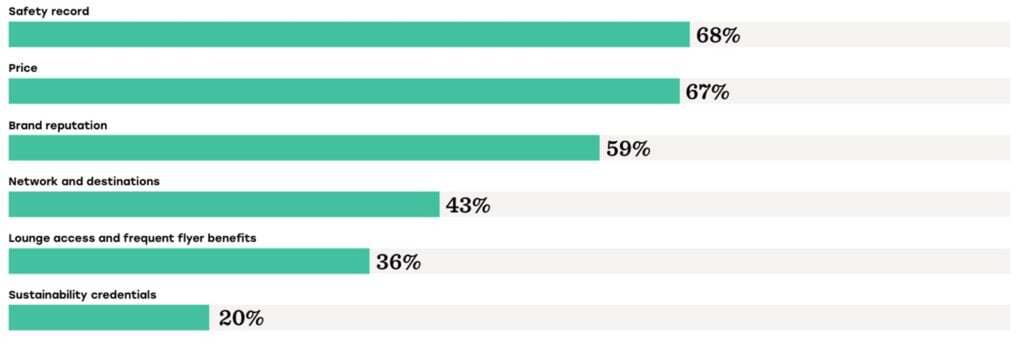
Close to 2/3rd of respondents(62%) said they would travel internationally within the next 1 year.
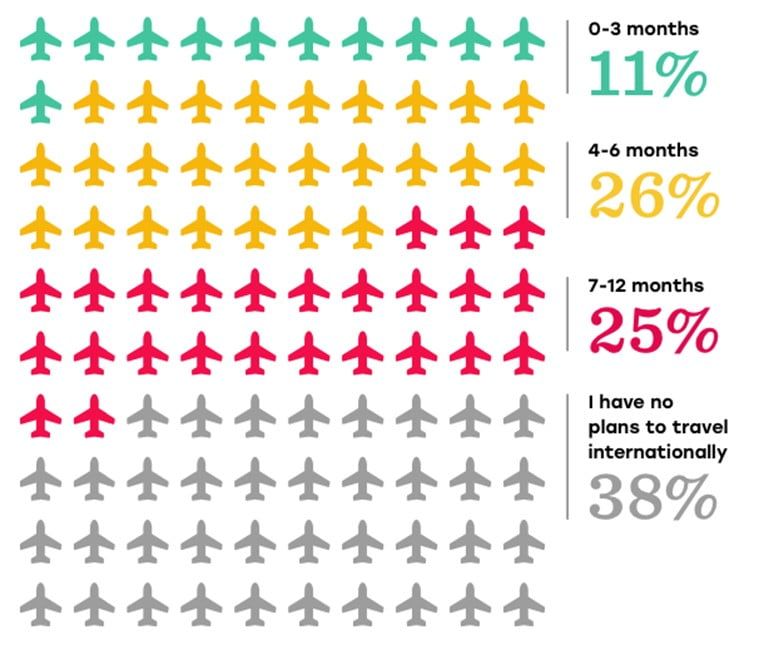
When asked their first choice of international destination, almost one- third (32%) selected South East Asia. Europe, Australia/New Zealand, and East Asia followed. The most popular international destinations outside of Asia were selected by a higher proportion of female respondents than males, while international destinations within Asia were more popular amongst the male respondents.
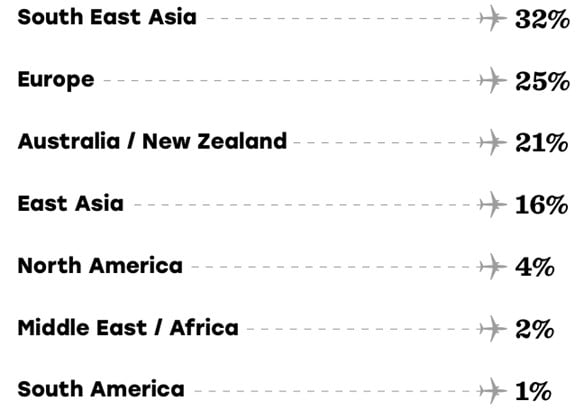
Singapore is rated as top destination (#2) for level of comfort as potential destination, while unsurprisingly Macau (#1) & Hong Kong (#2) are other top destinations.
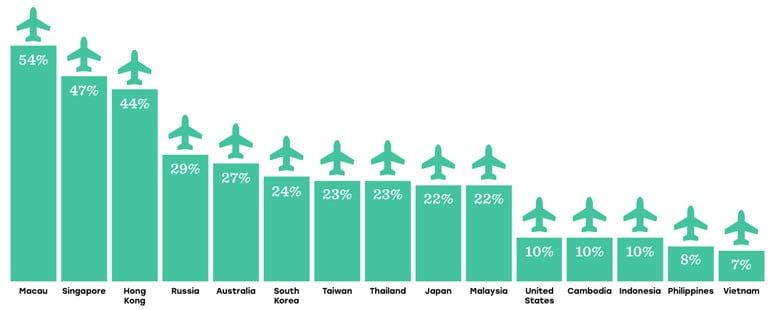
Travelling with close family (54%) or partner/spouse(56%) is more likely post pandemic than before. A significantly higher proportion of 18-29 year olds had grown more likely to travel with friends, compared to the rest of the sample (45% vs 22%). The same was true for female respondents as compared to male respondents (33% vs 24%).
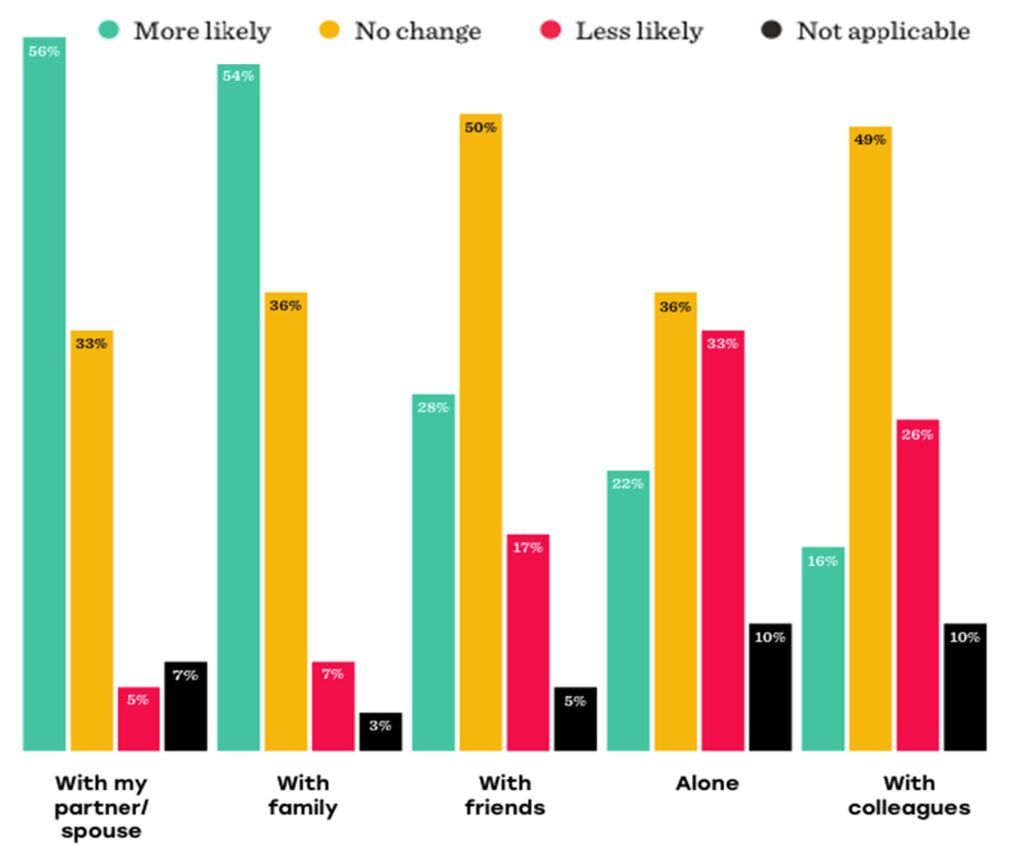
Get in touch for the full report or your marketing strategy post-pandemic.
INSIGHTS REPORT - GENZ CONSUMPTION
According to the white paper on Gen Z consumption power released by Tencent QQ Advertising, China’s Gen Z population (15-23 years old) is the largest, approx.149 million people, accounting for 40% of the overall consumption power. Generation Z have strong consumption power and dare to make money and spend, so consumption starts early. Their average monthly income is as high as 3500 yuan, especially for the 19-23 year-olds generation Z in school, 35% of which have multiple sources of income:
- Part-time outside school expenses (67%)
- The family provides living expenses (54%)
- On-campus work-study salary (40%)
- Scholarship (34%)
- Sell second-hand items (7%)

Self-identity
65% of Gen Z want to have a common language with friends. They are eager to socialize but have a lot of social pressure. In particular, heavy schoolwork limits the opportunity to face the outside world. They maintain their social circle by purchasing hot items that circulate in the group. Common topics, keep up with the trend in the circle and hope to better integrate into the circle.
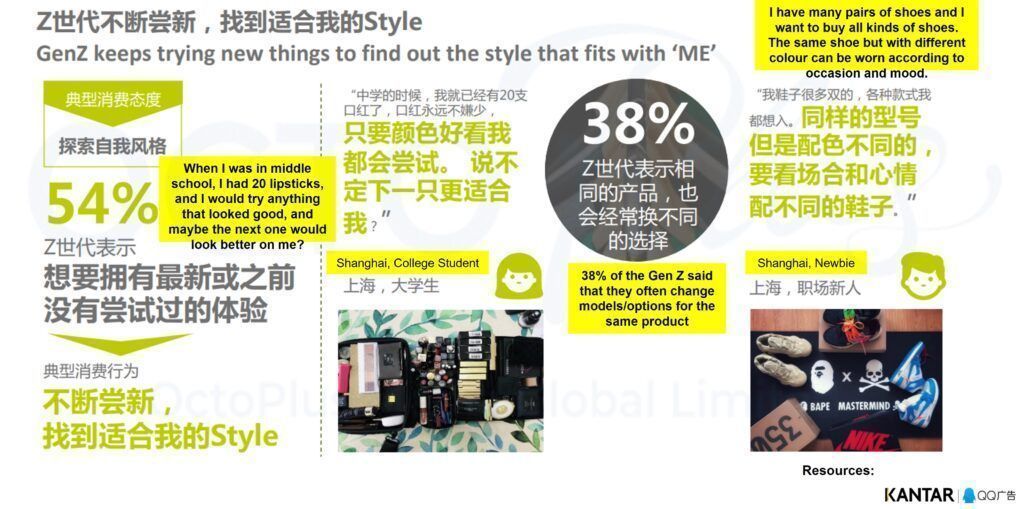
I am what I buy!
Generation Z likes to constantly explore and try different styles. They look for a lifestyle that suits them by consuming different brands and products. They are at an age to understand themselves, so before finding a style that suits them, Gen Z said that they want to have some unique experiences (such as limited editions) that they have not tried before, deepen their interest, and create their own exclusive Person setting.
My Micro-Moment
More than 50% of Gen Z agree that spending money is for happiness and satisfaction ‘at the moment’. Since the development of interest takes a long time to accumulate, in this long process, they will enjoy the instant happiness brought by having their favourite items and satisfy their immediate desire for happiness. For example, 31% of Gen Z have begun to use instalment payments. Because of the endless emergence of credit consumer products, which lowers the threshold for young people, they are willing to pay more to buy items that meet their preferences.
How can Marketers use these trends?
Social: Brands need to expand their brand influence to meet the needs of young people who love to socialize and build a stronger willingness to share, so it is suitable for using interactive innovative marketing
Personalized: Brands need to combine the interests of Gen Z to better arouse their attention to the brand and their willingness to seed content, suitable for vertical marketing that combines interests and hobbies
Impulsive Mico-moment: Brands need to use the influence of a strong social chain and community to guide and accelerate the buying decisions of Generation Z, which is suitable for precision marketing implanted in social occasions or private traffic via selected WeChat private groups.
How can we identify these groups of people?
Tencent Advertising and QQ Advertising are definitely some of the preferred platforms. Here are some advertising examples:


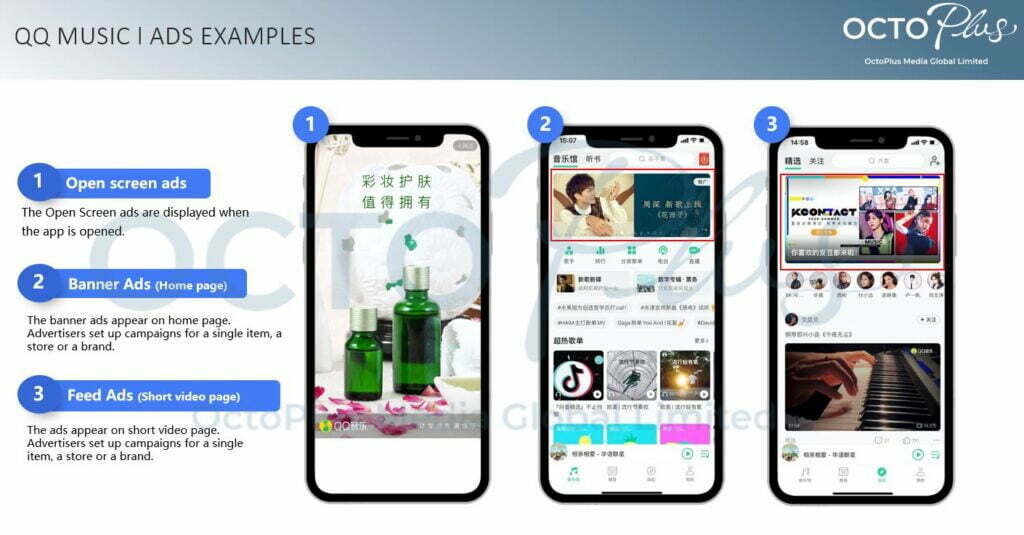
OTT COMMERCIALIZATION TRENDS AND MEDIA VALUE RESEARCH
According to the report on the commercialization of OTT released by Miaozhen, the number of people covered in the OTT market has increased steadily. Compared with 225 million in 2019, the number of OTT (Internet Television) in 2020 has reached 266 million units, an increase of 18.2%.
In 2022, the OTT market is estimated to reach 349 million units, and the household penetration rate will also reach 80%; by 2023, OTT is expected to cover 1 billion people. Based on the report, each large screen reaches an average of about 2.6 people. More than 50% of the family watch together, and more than 90% watch with others. Family scenes make large-screen marketing content innately shared and discussed, thus strongly affecting consumers’ purchasing decisions.


The new ecological construction of “integration + extension + service” and the commercialization trend of new family screens
Content is always an important starting point to drive family marketing, in order to cultivate user habits, enrich the business model of value-added services, between advertisers and resource parties, there will be “agents” this professional service party role, providing professional operations, integration of resources, marketing planning and other services. Under the commercialization trend of “integration + extension + service”, advertisers’ investment intentions in OTT have been continuously improved. The share of OTT investment in the digital advertising traffic pattern has increased from 11% in 2018 to 20% in2021. Advertisers generally recognize the value of the family scene, reach scale and reach mechanism of the new family screen. Compared with mobile terminals, Internet TELEVISION (OTT) has a more reach advantage in high-frequency arrival.
Miaozhen System provides an in-depth look at media users’ attitudes towards OTT advertising/marketing messaging touchpoints, as well as consumer performance in different industries. Represented by Youku users, the smart big screen (smart TV) is the most important advertising/new brand contact channel for Youku OTT users; OTT marketing can be used as a key touchpoint to seize users’ minds. Smart TV ads perform well in terms of user attitude indicators such as creativity, credibility and attractiveness, ranking first in smart TV ads, mobile phone/pad screen ads, fixed ads/pop-up ads (including APP open screen ads), live TV ads, long and short video ads and social media ads.
The new family screen is a high-quality traffic opportunity, with the improvement of OTT reach, the evolution of content power, the enhancement of touch power, its perfect commercialization model, considerable data performance, and irreplaceable family scenes, has become an important traffic growth point of brand marketing.
Get in touch if you would like to have the full report or are in need of OTT advertising.
INSIGHTS REPORT – 11.11 CELEBRITIES MARKETING REPORT
According to the “2021 Double Eleven Data Report” released by the WEIQ celebrity platform for Double Eleven this year, celebrities are still an important means of brand marketing. And this year’s Double 11 marketing content is the main core, and live broadcasts on major platforms are the main theme.
Overview
The data shows that advertisers have made new breakthroughs in their intentional and actual orders during Double 11 in 2021. The number of advertisers placing celebrities has increased by 65% over last year, and the number of participating brands has increased by 55%. In brand placement, celebrities have re-invested more than 80%. During this year’s Double 11 event, celebrities created content every 50 seconds on average.
Compared to 2020 –
The scale of launch shows that compared to 2020 the launch rate in 2021 has increased by 40%. It can be seen that the marketing and promotion of the brand by celebrities is still the most effective, and brands are more willing to invest their publicity budget in celebrities. In terms of proportions, compared to Weibo, Xiaohongshu and WeChat, Douyin’s share of the market has increased significantly, mainly because Douyin can attract users to the Tmall shopping platform, while other platforms currently do not support direct users to the online shopping platform.
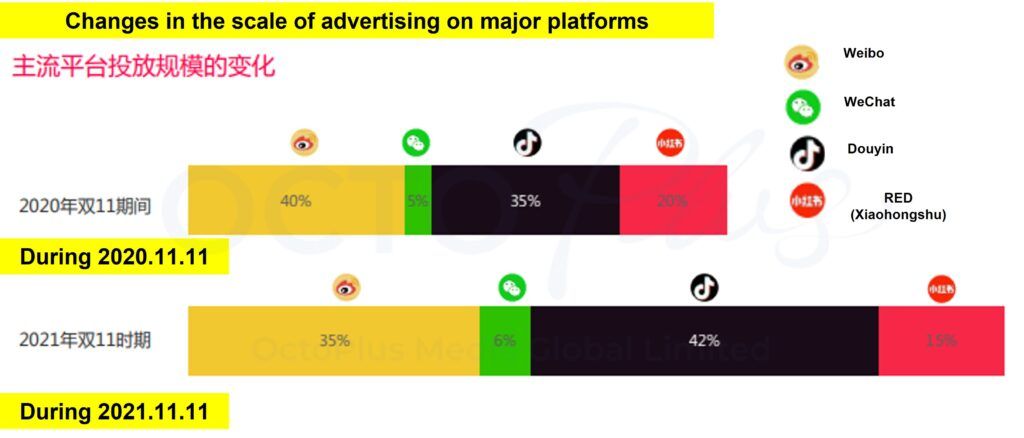
Characteristic of each platform
Weibo:
Based on graphics and long videos, nearly 30 related hot searches have triggered consumer engagement.
Celebrities have strong content extensibility on the platform, accelerate brand exposure
Beauty and fashion celebrities are favored by advertisers.
Platform stars and fan circles have a strong influence
Topic linkage helps products, forming a combination of Weibo volume and e-commerce value.
WeChat:
The overall delivery of the platform is still the mainstream of graphic content
The video account enriches the content ecology of the platform, and most of them are mainly for brand “product promotion”.
Emotional, life, culture, technology public accounts, all have long-term stable customers and audiences.
TikTok:
The platform has strong entertainment attributes with diverse forms of beauty, comedy, and dramatic plot content.
Short video placements and live streaming with goods are the two most important modes of delivery on the platform.
During the Double 11 period, the platform launched 10,000 live broadcasts, and brand self-broadcast and Dabo accounted for almost half of shares.
Little Red Book (Xiaohongshu):
Female users account for a large proportion, skincare and beauty fashion recommended, unboxed evaluation still occupy a large proportion of the platform.
Mid-level KOLs are more cost-effective than top celebrities or KOLs and are generally favored by brand owners.
The proportion of brand owners in KOC has increased, which is the main productivity of platform product planting.
The characteristics and appeals of celebrity marketing
The expansion of the online market has gradually increased the requirements of brands and audiences for content creation. Brands are increasingly able to grow and sell goods to celebrities, and their ability to convert sales is getting higher and higher, and they pay more attention to the value of content marketing. The audience’s ability to identify marketing content has become more mature, and the threshold and standards for celebrities in content creation have gradually increased. Celebrities must use a variety of forms to attract consumers, such as short videos, live broadcasts, evaluation notes, long pictures, etc. Celebrities have their own fan circles, and the precise selection of numbers ranges from “planting grass” to “pulling the grass” marketing closed-loop leads to highly effective conversion of product sales.
Case Study
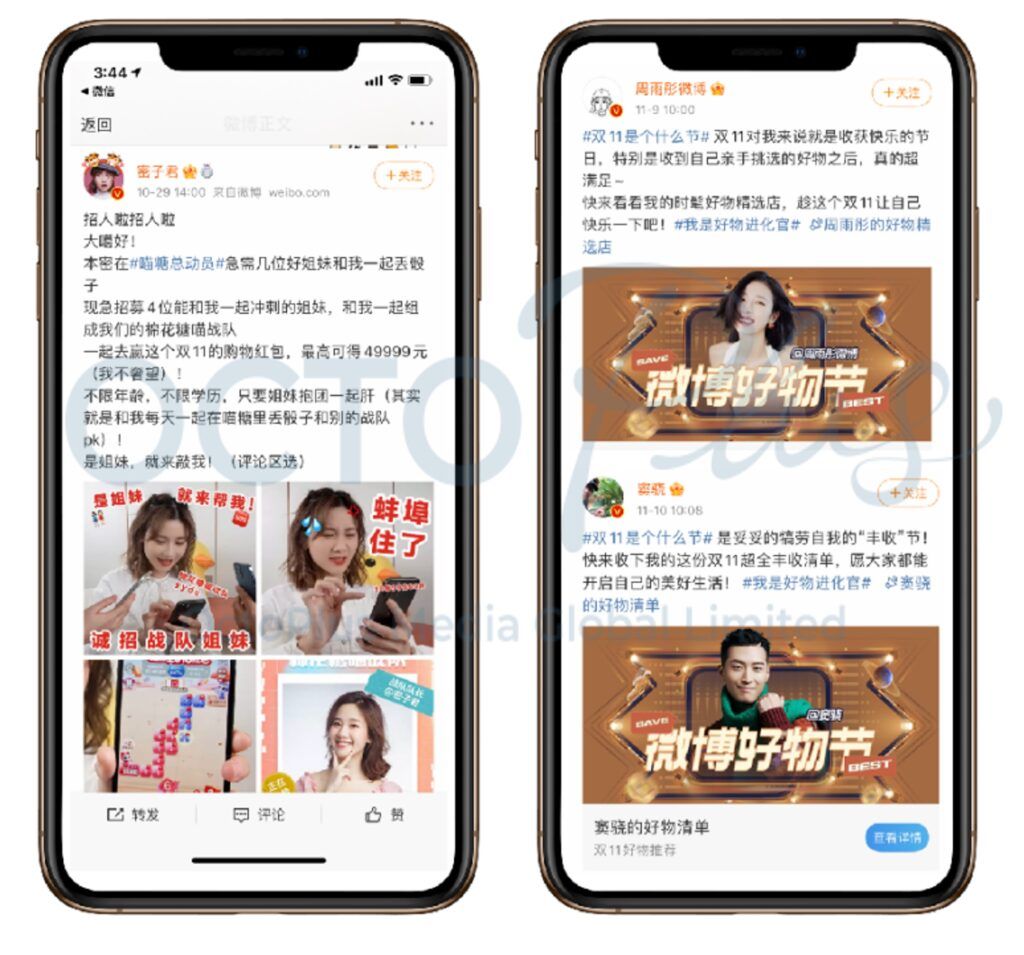
Campaign: Tmall Double 11 Weibo
Duration: 19/10 – 11/11
Total exposure: 460 million
Total interaction: 3.1million
Strategy: Use Weibo KOL+KOC+ small V talent matrix resources to help Tmall’s event marketing in the Weibo field, and spread diversified gameplay activities and double 11 preferential information on Tmall.com.
Take advantage of the celebrity effect of Weibo to create celebrity social marketing for the main topic of Double 11, leverage fan participation, and maximize the spread of topic influence to e-commerce, so as to increase user purchase conversion.
Campaign: Tmall Double 11 Explosive List Spread
Duration: 25/10 – 13/11
Total exposure: 330 million +
Total interaction: 2 million
Core Gameplay: 2021 Tmall Double 11 “Tmall Official Hot item List” and “Sina Weibo” to create a #BurstIngBeautifulLife# (#爆美好的生活#) topic activity, the topic page online theme content collection, celebrity life report release, explosive good things creative planting contest and other gameplay, inviting stars, big V, users to participate in co-creation.
Relying on Weibo Entertainment’s own star short video planting IP, taking advantage of Tmall business opportunities, forming a two-way bonus of Weibo voice + e-commerce value. Through the integration of Weibo sound volume and Tmall sales, brings business value, and continuously affects users’ minds with content-based grass and shortens the purchase decision path.
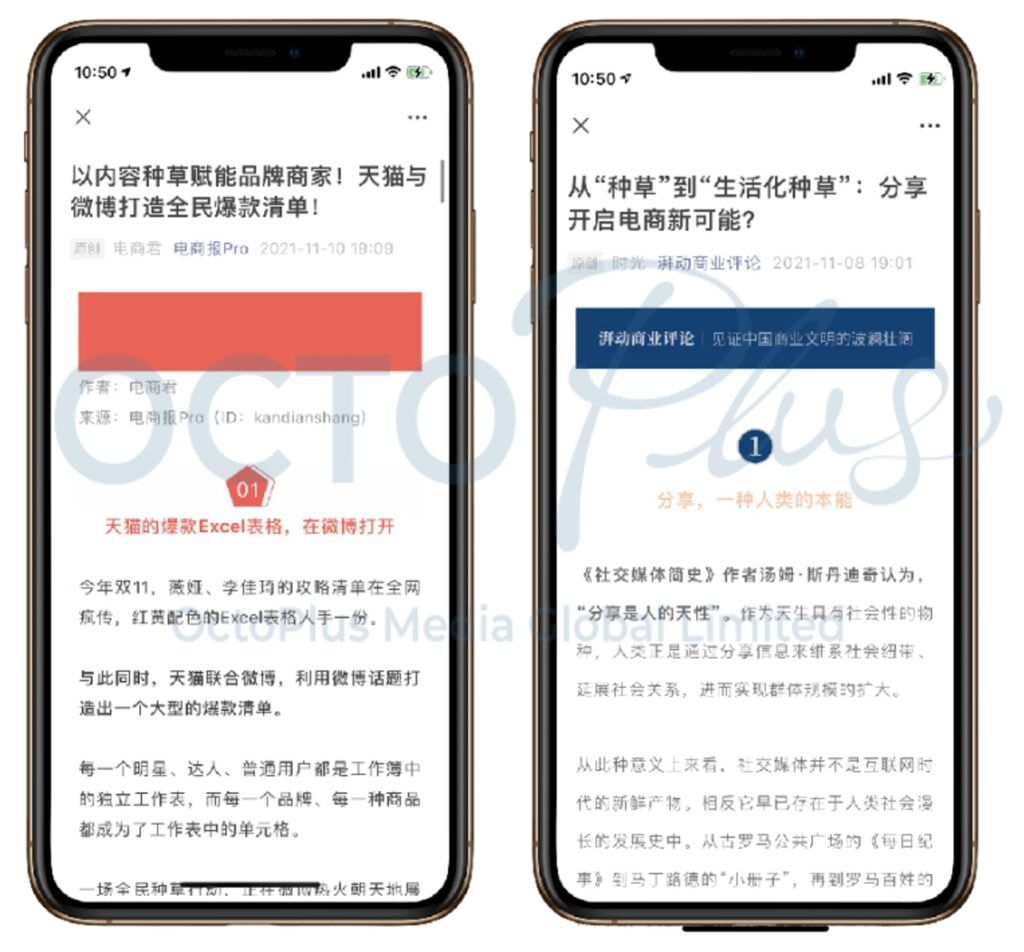

APP OF THE MONTH - AUTONAVI / GAODE MAP
AutoNavi Maps is a professional navigation platform with accurate data in China. It is currently used by more than 700 million users, covering 90% of car owners across the country for driving and comprehensive car owner services, and it has covered more than 60 one-stop taxi-hailing platforms, ranking first in the travel industry.
AutoNavi Map has comprehensive functions: precise positioning, search, intelligent route planning and voice navigation. Its navigation service also provides positioning services for 400,000 apps such as Toutiao, Weibo, and Apple Maps, and has 500 million monthly active users. In addition, AutoNavi Maps provides 350 domain bus data and 30 domain real-time bus dynamics, allowing users to easily grasp and use bus services.
Demographic:
40% female ; 60% male
25-34 years old users accounted for the highest proportion; followed by 35-44 years old, 19-24 years old, 45-54 years old
91.28% of users with a university degree or above
Affluent users — 0.01% of the top rich (covering nearly 500,000 people); 3.07% of the rich (covering nearly 15.35 million people);
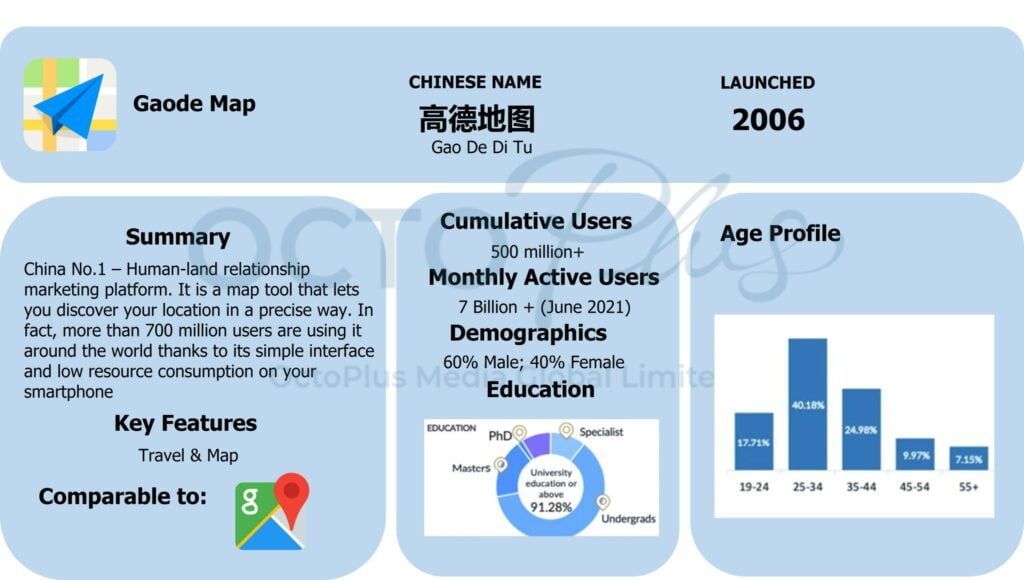
AutoNavi Advantage
77.8% of China’s consumption amount/behaviour are offline, and AutoNavi Map covers all offline consumption scenes, such as various active marketing scene videos/information/offline screens, etc., which become the advantage of scene connection. AutoNavi Map has multi-dimensional data sources, using One ID to restore different data sources to a single user, and also has exclusive/recommended tags such as basic attribute tags, car usage tags, LBS location tags, and APP installation tags.
In addition, AutoNavi Map’s unique data relationship can accurately locate the target population with demographic information and geographic coordinates. Its information includes location information, basic information, car information; geographic coordinates-brand store coordinates, business type coordinates, geofence.
Advertising Products
The marketing resources of AutoNavi Maps include advertising forms such as the screen opening before travelling and the banner map:
Open screen: open the AutoNavi app for the first time exposure, display pictures or videos in full screen (no sound); full screen can be clicked and linked
Navigation end page: exposed at the end of the navigation, closely connected with destination consumer behaviour, can distinguish different scenes of driving/public transportation/cycling/walking; displayed as banner, clickable to jump and external link
Small blue bar/message box: displayed on the map or on the message centre page; you can click to jump, and you can link to it
Voice package/voice broadcast: broadcast by voice at the beginning of the navigation, during navigation, and at the end of the navigation; can display audio and video effects, oral broadcast of the brand slogan.
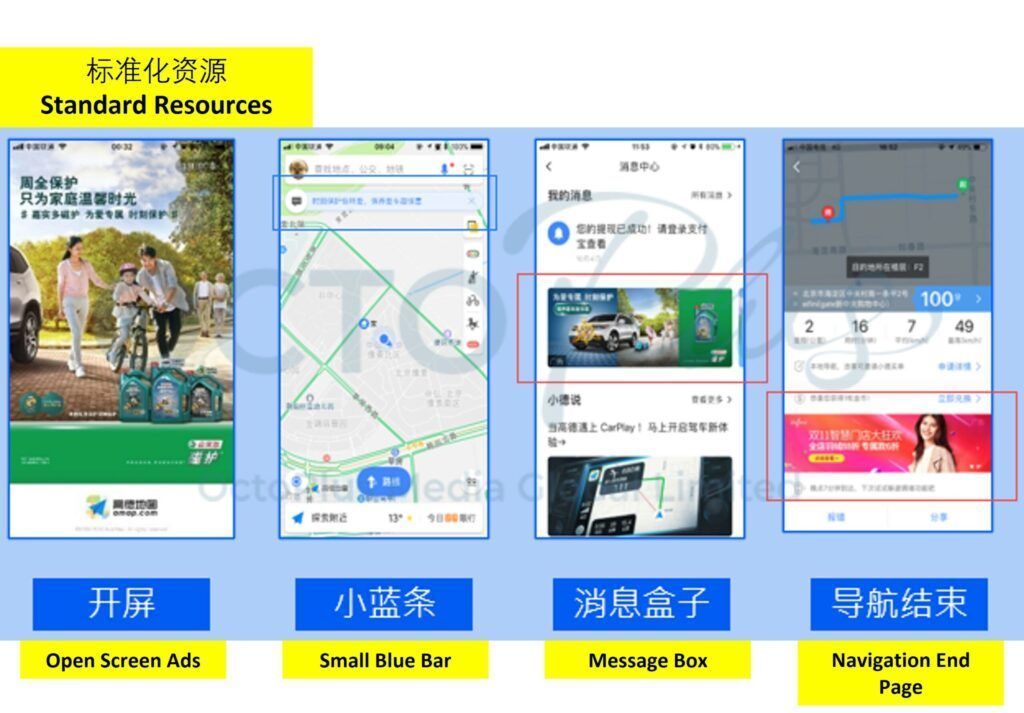
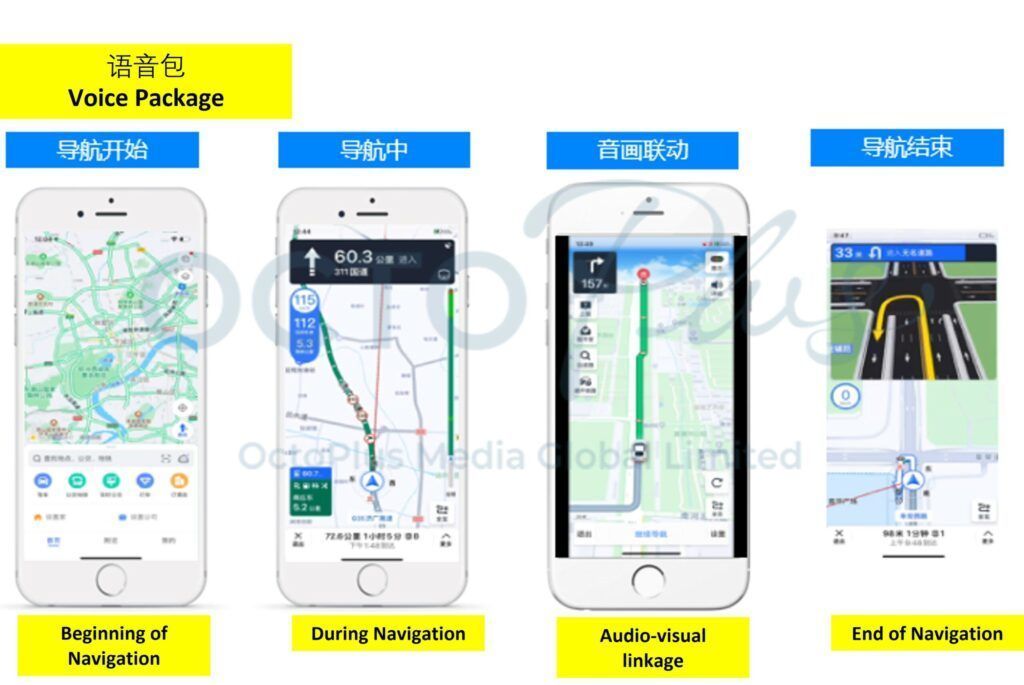

If you want to know more about AutoNavi Map’s products and marketing cooperation, please contact us!
-End of the Newsletter-
Feel free to talk to us
It’s a team with one single shared goal, which is our client’s success. Deliver results for your business now.
